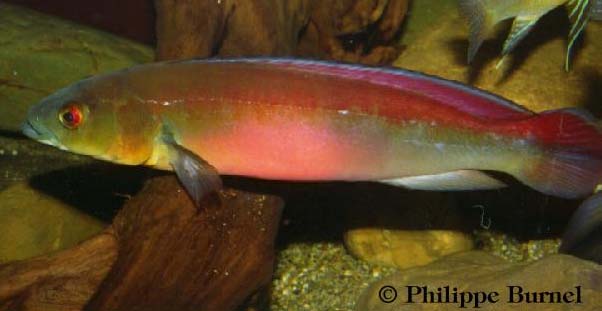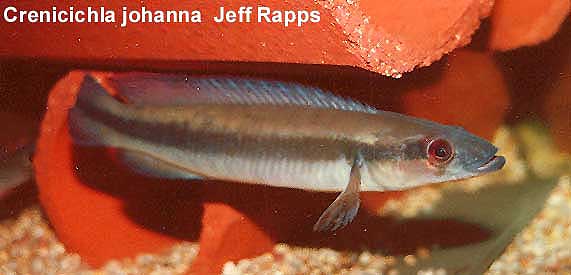

Crenicichla johanna Heckel, 1840
Group: Lugubris
Distribution: Almost the entire Amazon basin including the Guyanas to the north and Rio Guapore to the south.
Type Locality: Rio Guapore, Matto Grosso, Brazil
Size: 12-14 inches
Comments: this species and an undescribed species from Venezuela and Colombia were the most common members of the lugubris group in the North American aquarium hobby, until the exportation of Crenicichla sp. Xingu 1 in the late 1980s. This is the fish pictured on the cover of the popular Aqualog South American Cichlids I. There are numerous color morphs owing to its wide distribution. This species could quite possibly have the largest distribution of any of the pike cichlids. I have kept three color morphs of this species - a very attractive form from the Guyanas and another equally attractive color morph from Peru. The third was very different from the others in having a much smaller head and a less-than-striking coloration - it was exported from Rio Tocantins area. The smaller head of this form gives it a very elongated appearance. It is quite possible that with further ichthyological attention to these subtle differences, that these forms like those of the previous 'Cichlasoma festivum' complex could find themselves eleveted to specific status.
They have a very prominent lateral band, which makes this fish appear as if it lacks a humeral blotch (shoulder spot) and caudal spot (tail spot). There is usually a red horizontal band above the lateral band in adults. Its nostril is placed uniquely for a lugubris group pike - almost touching the upper lip. Also, some morphs have a blunt or flattened lower jaw/lip, as if the fish ran into the glass of the aquarium very fast! There is no mistaking this fish for any other pike cichlid.
In aquaria, their behavior has proven to varied as well. Some have been fairly peaceful while others violently intolerant of conspecifics and other Crenicichla. They are very hardy but do succumb to neuromast erosion (hole-in-the-head)if raised in poor water. They eagerly consume prepared foods and often become quite tame with the keeper. I was unable to get them to spawn despite all efforts. This species has refused to spawn in captivity but my guess is that this will be the next lugubris group pike to be spawned. If I were to try again, I would start with a very large aquarium (200 gallon or larger) and acquire specimens from white water habitats, conditions that are easily duplicated in aquaria. Once a pair bond has been established, I would perform large and frequent water changes and feed live and frozen foods copiously.
Described in: Annalen des Wiener Museums 2; p 425-427
| Back to ==> Home / Pike Photos / C. johanna |
| Home | Pikes | Neotropicals | Collecting | Photography | Personal | Links | Site map |

|
http://geocities.datacellar.net/NapaValley/5491
Latest update: 31 May 2000 Comments on this page: E-Mail author |
 Back to Species list
Back to Species list